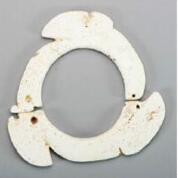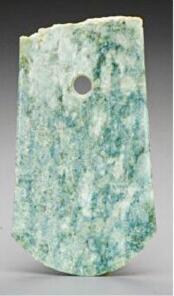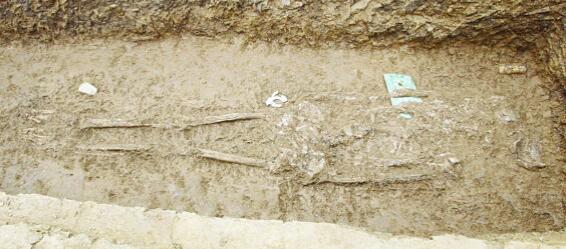High-ranked cemetery of Qujialing Culture found in Mulintou site in Hubei
Mulintou site is located in Xiangyang City, Hubei Province. The site is mainly distributed on the southwest part of Ziyang terrace, covering an area of about 80,000 square meters. From August 2017 to January 2018, initiative archaeological survey, prospection and excavation of Mulintou site have been conducted by Hubei Provincial Institute of Cultural Relics and Archaeology. Excavated zone can be divided into two parts, the east part and the west part. Excavated area of the east part is 64 square meters, while the exact unearthed area of west part covers more than 240 square meters.

Assemblages from tomb M18
Cultural remains of this season’s excavation mainly include Neolithic cultural layers and disturbed Western Zhou cultural layers. Qujialing cultural features include 3 housing foundations, 11 ash pits, 1 ash ditch and 23 tombs. Besides, there is 1 ash pit from Western Zhou Dynasty, 3 tombs from Eastern Zhou Dynasty, 2 ash pits and 2 tombs from Han Dynasty, 1 ash pit from Song Dynasty and 8 tombs from Qing Dynasty as well.
Qujialing cultural remains spread in the whole excavated zone with relatively thick cultural deposits, about 0.6~1.4 m thick. Tombs all are rectangular or trapezoidal shaft earthen pit tombs. They are distributed rather intensively, seldom be broken each other. Most of the deceased are heading south, north, east or west, only a few head southwest. The majority of the tombs are single burials with a tomb owner lying on its back with straight limbs. There are only a few two people or three people co-burials. Premier burials take the largest percentages of all burials. There are a small number of secondary burials, too. There is no funeral furniture so that most of the skeletons are very fragile and poorly preserved.
There are relatively a number of burial gifts from each tomb. Most of them are potteries. There are also some stone tools, jade artifacts and bone artifacts. The majority of the burial goods are placed around the head or on both sides of the deceased. There are a few being put on tomb owner’s body. Among potteries unearthed from the tombs, cups are the mainstream, more than 400 pieces of pottery cups have been recovered, most of which are black clay or gray clay potteries. Relatively few of them are red clay or painted potteries. Besides, there are also some sand-tempered potteries. The main parts of potteries are plain. Only a few have string pattern, carving pattern or additional heap pattern. Moreover, there are some painted potteries, too. The recognizable pottery shape have pottery ding-cauldrons, dou-vessels with double bellies, bowls with double bellies, jars with high collar, bowls with ring foot, cups with high foot, lids, bo-bowls, pottery cups, small pottery jars, spindle whorls, pottery rings and so on. Whole bodies of stone artifacts are polished,including perforated stone yue-axes, gui-elongated pointed tablets, axes, adzes, arrowheads, knives, chisels and so on. Jade artifacts are relatively few, which range from perforated jade yue-axes, perforated jade armillary sphere (Jade Xuanji It is a flat disk similar in shape to the bi-disk, except that the outer edge is broken into an irregular serration of major and minor projecting teeth, much like a circular saw blade), jade axes, jade pipes and etc. There are only a few broken bone artifacts, including ivory tubes, bone awls and so on.
Several high-ranked tombs from Qujialing cultural period have been discovered from this excavation with a series of important artifacts, which play a significant role in understanding contemporary high-rank tombs.

Jade Xuanji It is a flat disk similar in shape to the bi-disk, except that the outer edge is broken into an irregular serration of major and minor projecting teeth, much like a circular saw blade

Jade yue-axes
M26 and M33 are a set of co-burial in different graves
There are relatively a number of burial gifts from each tomb. Most of them are potteries. There are also some stone tools, jade artifacts and bone artifacts. The majority of the burial goods are placed around the head or on both sides of the deceased. There are a few being put on tomb owner’s body. Among potteries unearthed from the tombs, cups are the mainstream, more than 400 pieces of pottery cups have been recovered, most of which are black clay or gray clay potteries. Relatively few of them are red clay or painted potteries. Besides, there are also some sand-tempered potteries. The main parts of potteries are plain. Only a few have string pattern, carving pattern or additional heap pattern. Moreover, there are some painted potteries, too. The recognizable pottery shape have pottery ding-cauldrons, dou-vessels with double bellies, bowls with double bellies, jars with high collar, bowls with ring foot, cups with high foot, lids, bo-bowls, pottery cups, small pottery jars, spindle whorls, pottery rings and so on. Whole bodies of stone artifacts are polished,including perforated stone yue-axes, gui-elongated pointed tablets, axes, adzes, arrowheads, knives, chisels and so on. Jade artifacts are relatively few, which range from perforated jade yue-axes, perforated jade armillary sphere (Jade Xuanji It is a flat disk similar in shape to the bi-disk, except that the outer edge is broken into an irregular serration of major and minor projecting teeth, much like a circular saw blade), jade axes, jade pipes and etc. There are only a few broken bone artifacts, including ivory tubes, bone awls and so on.
Several high-ranked tombs from Qujialing cultural period have been discovered from this excavation with a series of important artifacts, which play a significant role in understanding contemporary high-rank tombs.

Jade yue-axes jade Xuanji and ivory tube in situ

Assemblages from tomb M26
M26 is a rectangular earthen shaft pit tomb with a raw soil second-tiered platform, 230cm long from east to west and 160cm wide from south to north and 84cm deep. No funeral furniture has been found. According to traces of human skeleton, the deceased was lying on its back with straight limbs. The tomb owner is predicted to be 180 cm high. Among the burial goods, the jade yue-axe is 22cm long and 16cm wide, which is under the right humerus and the back. The jade Xuanji was broken into two pieces, being placed on right palm of tomb owner. The jade axe was put on one side of the right shin. There is an ivory tube on the right side of the head. Most of buried potteries are on the raw-earth second-tiered platform. Only a few potteries are put on the deceased or on its both sides, which are probably funeral furniture. All potteries are broken. More than 20 pieces could be recovered. Recognizable shapes of the potteries have cups with high foot, dou-vessels with double bellies, pot-shaped vessels, yu-vessels with broad mouth, jars, gang-urns as well as painted dou-vessels, painted jars and painted stands and so on.

Jade yue-axes and potteries in situ
M33 is a rectangular earthen shaft pit tomb. The tomb grave is 210cm long from east to west, 92cm wide from south to north and 72cm deep. Walls of the grave are smooth and the bottom is flat. There is no funeral furniture and no obvious trace of human skeleton. Only broken pieces of teeth are found. Buried potteries goods are rather fragmentized. Recognizable shapes of potteries have cups with high foot, yu- vessels with broad mouth, dou-vessels with double bellies and jars and so on. What’s more, there is a stone yue- axe on the position of the head of the tomb owner.
Excavated area of this season is a family cemetery of Qujialing cultural period. Tombs of the cemetery have so rich and elegant burial gifts that haven’t been found in other Qujialing cultural period tombs ever before. Artifacts such as jade yue-axes, jade armillary spheres, ivory tubes and so on are even the first discoveries of their kinds in Qujialing cultural remains. According to power symbols such as jade yue-axes, jade armillary spheres (Jade BI-disc in the form of tooth) and etc. buried in M23 and M26, it’s predicted that their tomb owners should be leaders as a chief of a tribe. Because all the tombs have rich burial goods, this family cemetery is probably a relatively high-ranked family cemetery. This indicates that Mulintou site could be a relatively high-ranked settlement in this area during Qujialing cultural period. (Translator: Ma Huanhuan) Cultural remains of this season’s excavation mainly include Neolithic cultural layers and disturbed Western Zhou cultural layers. Qujialing cultural features include 3 housing foundations, 11 ash pits, 1 ash ditch and 23 tombs. Besides, there is 1 ash pit from Western Zhou Dynasty, 3 tombs from Eastern Zhou Dynasty, 2 ash pits and 2 tombs from Han Dynasty, 1 ash pit from Song Dynasty and 8 tombs from Qing Dynasty as well.

